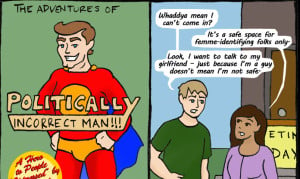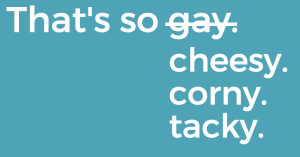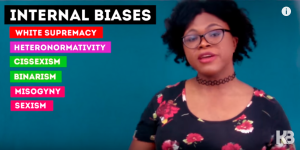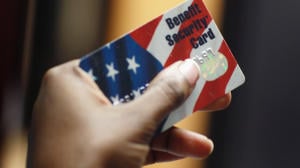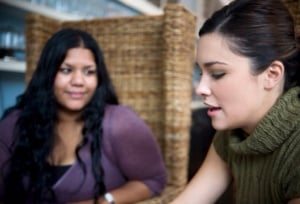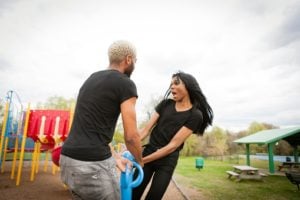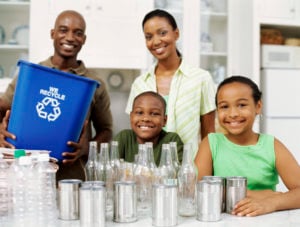
A smiling family of four pose with their recycling.
My childhood was sprinkled with eco-conscious guidance. In an ever-growing urban world, it’s of the utmost importance that our children learn how to face environmental challenges.
Children are naturally curious. By asking the hard questions – Are our habits or routines harmful? Can we alter them to improve the quality of life for future generations? Do I spend enough time thinking about the effect my choices have on the earth? – and encouraging wonder, we can do our part to create a brighter, more conscious future.
In the name of awareness, I’ve picked six major environmental problems and turned some possible solutions into fun learning experiences.
1. Carbon Footprints and Climate Change
Crude oil prices and production rates dropping and green/renewable energy gaining popularity illustrate the good news that more Americans have acknowledged our global warming reality and are taking steps to counter it. This shows that big changes happen when we all work together!
This is arguably the biggest issue, so I kept the project pretty breezy.
What You’ll Need:
- Internet access
- This carbon calculator (or another like it)
What You’ll Do:
- Gather the whole family, and fill it out!
- See the changes you can all make to be better and more efficient. Family members should get rewarded for remembering to turn off lights upon leaving rooms or shortening their shower time, and so on.
Parents, a home energy audit might also be a good idea.
2. Biodiversity Nature Hike
I had the good fortune to travel quite a bit as a child, meaning I was outside a lot and absolutely loved it. I learned the importance of leaving nature as I found her. In Girl Scouts, that was known as “leaving no trace.”
Ecosystems exist perfectly. Every little thing is necessary and has purpose. These videos are great tools for explaining to your children what biodiversity is and how natural systems coexist. Nature is really good at finding balance by itself, especially with healthy diversity.
The more humans interact with nature, the more likely imbalance becomes. That certainly doesn’t mean you can’t play outside. It simply means that you should be aware and gentle to the earth while doing so.
Learn more about biodiversity by exploring your own backyard!
What You’ll Need:
- A nearby natural habitat (backyard, park, beach)
- A notebook
- A writing utensil
What You’ll Do:
- Pick an area.
- Carefully observe and take note of all living things that exist there. Bugs in the soil, flowers/moss growing up tree trunks, birds and squirrels in the branches.
- Discuss how each of those pieces are integral parts of our planet. Discuss what might happen if just one of them were to be taken away. (What things benefit from flowers? What else do the flowers benefit from?)
- There’s always the option of taking pictures, printing them out, and making them into flashcards.
The World Wildlife Fund has put together their 2016 Living Planet Report (and summary) which states that there are some “signs that we are beginning a transition towards an ecologically sustainable future.”
While options like switching to farmer’s markets to reduce the impact of modern agriculture and paying attention to packaging and ingredients can go a long way, helping people understand the perfect, intricate systems that keep our planet in balance can be an extremely powerful tool.
3. Family Pollution Police
Growing up as a nature-loving empath in an ever-advancing sometimes out-of-reach world, I always felt like I cared too much. People judged me for years for picking up other people’s litter. Pollution statistics can be overwhelming, but scientists and activists are doing a pretty bang-up job of innovating new ways to use green energy.
It is our responsibility to protect and preserve that which takes care of us. Why not promote family time in the process?
What You’ll Need:
- Biodegradable/compostable garbage bags (these are affordable)
- Gloves (more biodegradable options!) or one reach extender per person
- Bikes, skateboards, rollerblades (are those still around?), or just a good pair of shoes
What You’ll Do:
- Get moving! As a family, travel around your neighborhood or to your nearby parks picking up all the trash you can find.
- The person who picks up the most trash wears the badge (made from reused/recycled material, of course) awarded to that week’s most prestigious pollution officer.
I’ve always found it disheartening that community service is used as a punishment. We should feel pride in cleaning our communities. Invite friends and make it a potluck event!
4. Commercial for Water Awareness
Every place I’ve called home has been between ten and thirty minutes from a body of water, so it’s always been close to my heart. (Mni Wiconi.)
We’re all familiar with the standard (still very helpful) approaches to conservation. Using more efficient appliances, turning off the faucet while brushing our teeth and washing our hands, and switching to eco-friendly products. This approach inspires creative thought and allows the whole family to learn about other issues!
What You’ll Need:
- Various research materials (remember encyclopedias?)
- Different ways to propose an advertisement (PowerPoint, spoken piece, poster)
What You’ll Do:
- Everyone picks an animal from a different continent.
- Research your animal’s relationship with water. Describe the animal’s habitat, and discuss any potential water issues (drought, toxicity, predators).
- Create an advertisement persuading your family to take action regarding those issues.
- Talk about what those actions might look like. If competition is desired, have the family vote for a winner.
If we keep producing and consuming energy the way that we do, clean water accessibility will change drastically by the year 2040. If we keep paying attention to our habits, positive changes will occur.
5. Homemade Paper and Deforestation
I’ve risked ruining many dresses to climb a good tree, and the original tree-huggers are my soulmates.
Everything from clothing to personal hygiene products takes a toll on our global forests, which provide the biodiversity our planet thrives upon. Deforestation accounts for an estimated 15% of total greenhouse gas emissions.
By using old paper to make new, and incorporating new growth via seeds, children can really grasp a basic understanding of the life-death-life cycle.
What You’ll Need:
- Paper (junk mail, newspaper, construction paper for color, but nothing glossy)
- Blender
- Water
- Craft sticks (eight per person)
- Cheesecloth (one 12”x12” piece per person)
- Waterproof tape
- Glue
- Scissors
- 13 x 9 inch pan
- Kitchen towels (two per person)
- Sponge
- Seeds of your choice
- Wire rack
What You’ll Do:
- Tear the paper into pieces about one or two inches (about 1.5 cups/person).
- Put paper into the blender and cover with warm water. Let it soak while you assemble your frame:
- Glue four craft sticks at their corners in a basic square shape.
- Lay a section of cheesecloth over the square.
- Glue two more craft sticks (one on either side) over the cheesecloth, pulling the cheesecloth tight as you go.
- Cut the edges of two more craft sticks so they fit at the top and bottom, and glue them down to complete the frame.
- Trim the excess cheesecloth.
- Add waterproof tape over the wooden part of the frame.
- Lay a book on top while drying.
- Blend your soaked paper into a fairly smooth paste.
- Fill your pan about halfway up with water.
- Pour your paper paste into the pan and stir.
- Sprinkle some of your seeds into the pan.
- Lay out a towel on your counter. Holding your screen on either side, dip the screen into the pan, and scoop up some of the paper pulp. Using a spoon may be helpful.
- Shake the screen some to level it out, and lay it down on the towel.
- Sprinkle some more seeds on top, and gently press them down.
- Lay your second towel across the top, and gently flip the whole thing over so it now lays flat upside down.
- Gently absorb excess water with the sponge and then transfer to a wire rack to dry, up to 24 hours.
You can put these directly into the ground or a pot with soil. Your flowers should sprout in about a week! Cutting your seed paper into cute shapes to make ornaments, or gifting mini gardens as party favors or holiday presents is a great way to share your new knowledge!
Switching from many household disposable items to their compostable or reusable counterparts makes a big difference, too. A more intense change would be boycotting companies benefitting from and products contributing to deforestation.
6. Composting for Waste Disposal
Several cities, such as San Francisco and Kamikatsu, Japan, are paving the way for a cleaner future by zeroing in on a zero-waste lifestyle. According to the EPA, food makes up about one-fifth of America’s solid waste. Due to their methane emissions and the lack of viable land to make more, landfills are becoming a big problem.
One major way we can help as individuals is through composting, the benefits of which are undeniable.
The best approach to most major lifestyle changes is to start small! Generally, compost is done in large bins or a heap outside. Here are a few kid-centric videos explaining a couple different kinds of compost and why it’s helpful for the environment. Next, I will lay down the basics of a small compost project that can be done whether you have a yard or not.
There are two major components to healthy compost: green stuff (grass trimmings and food scraps) that is rich in nitrogen and provides moisture needed to produce the healthy bacteria for which compost is known; and brown stuff (dry leaves, nut shells, or recyclable paper) that is rich in carbon and helps absorb some of that moisture. You’ll want to layer these components in your bin along with a layer of soil.
What You’ll Need:
- A large, airtight bin and lid (think this plus lid, or this)
- Soil
- Something to drill holes in bottom of container
- Some sort of tray for potential fluid leakage (think paint tray, or a disposable baking pan)
- A way to keep the container elevated in tray
- Atool for stirring (this will depend on the size of your container, but a designated metal serving spoon would work)
- Aspot to store it (under the kitchen sink seems to be a standard)
Optional:
- Two smaller containers, one for soil and one for the brown stuff. This is mainly for convenience. I live in an apartment without a yard, so my paper recyclables just come straight from their recycling spot. Soil can also just be gathered from outside as needed.
- Decorating your bin can be a fun add-on for your little ones
What You’ll Do:
- Begin by setting up your tray and elevation pieces. This would also be the easiest time to decorate!
- Next, drill about 15-25 holes in the bottom of the bin. Too much moisture can make your compost rot, and you won’t be able to use it. Be sure to keep in mind the placement of the materials used to elevate the bin so they don’t block the holes.
- Now you can begin layering. Start with one or two inches of brown stuff (dead leaves, shredded/torn up newspaper, junk mail). Then comes the daily green – your banana peels, egg shells, vegetable peelings, and so on. Layer three will be brown again. You’ll always want more brown than green to avoid too much moisture. Layer four is an inch or so of soil.
- Give everything a stir, and that’s it! Keep layering like this daily/weekly until your bin is full.
- Once full, stir occasionally and check for moisture for a couple of weeks until all you have left is a bucket of nutrient-dense soil!
If you live in a dry area or don’t create much moist food waste, you may need to occasionally add water. You’ll know you’ve added too much if it leaks from the holes. For leaks and bad smells, add more brown stuff.
Some people recommend having two sets of compost; while one is full and processing, you can start filling up the other. If you don’t have a yard, try donating your compost to a community garden, using it for growing indoor plants, or starting a garden of your own!
***
There is much work to do, but small shifts in awareness can go a long way. Being perfect is impossible, but we must always be better. I like to research the measures taken at state level. In Louisiana, old Christmas trees are collected and deposited along the Gulf Coast to combat wetland loss. Everyone, including our young dreamers and innovators, needs to be held accountable.
Upon realizing what our President-Elect promised to do to all of the hard work, heart, dedication, time, energy, money, fresh thought, and trust that went into recent advances in environmental studies, I knew it was my job to get busy. Fortunately, there are others who are busy fighting the good fight on a larger scale!
Dr. Seuss had it right when penning The Lorax: “Unless someone like you cares a whole awful lot, nothing is going to get better. It’s not.”
[do_widget id=’text-101′]
Search our 3000+ articles!
Read our articles about:
Our online racial justice training
Used by hundreds of universities, non-profits, and businesses.
Click to learn more






